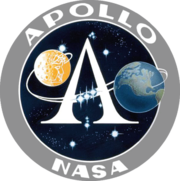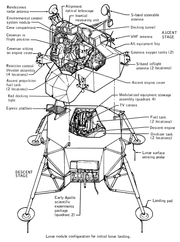Lunar module

Apollo 16 LM Orion on the lunar surface
|
|
| Manufacturer | Grumman Aircraft |
|---|---|
| Designer | Thomas J. Kelly |
| Country of origin | United States |
| Operator | NASA |
| Applications | Manned lunar landing |
| Specifications | |
| Design life | 75 hours (Extended) |
| Launch mass | 33,500 pounds (15,200 kg) initial 36,200 pounds (16,400 kg) Extended |
| Crew capacity | 2 |
| Dimensions | 23 feet 1 inch (7.04 m) high 31 feet (9.4 m) wide 31 feet (9.4 m) deep overall, landing gear deployed |
| Volume | 235 cubic feet (6.7 m3) |
| Power | Batteries |
| Regime | Lunar orbit |
| Production | |
| Status | Retired |
| Built | 15 |
| Launched | 10 |
| Operational | 10 |
| Failed | 0 |
| Lost | 0 |
| First launch | January 22, 1968 |
| Last launch | December 7, 1972 |
| Last retirement | December 14, 1972 |
  Apollo LM diagram |
|
The Apollo Lunar Module (LM), originally designated the Lunar Excursion Module (LEM), was the lander portion of the Apollo spacecraft built for the US Apollo program by Grumman Aircraft to carry a crew of two from lunar orbit to the surface and back. Designed for lunar orbit rendezvous, it consisted of an ascent stage and descent stage, and was ferried to lunar orbit by its companion Command and Service Module (CSM), a separate spacecraft of approximately twice its mass, which also took the astronauts home to Earth. After completing its mission, the LM was discarded. It was capable of operation only in outer space; structurally and aerodynamically it was incapable of flight through the Earth's atmosphere. The Lunar Module was the first manned spacecraft to operate exclusively in the airless vacuum of space.
Six such craft successfully landed on the Moon between 1969 and 1972. A seventh provided propulsion and life support for the crew of Apollo 13 when their CSM was disabled by an oxygen tank explosion en route to the Moon.
The LM's development was plagued with problems which delayed its first unmanned flight by about ten months, and its first manned flight by about three months. Despite this, the LM eventually became the most reliable component of the Apollo/Saturn space vehicle, the only component never to suffer a failure that significantly affected a mission.
The total cost of the LM for development and the units produced was $21.3B in 2016 dollars, adjusting from a nominal total of $2.2B using the NASA New Start Inflation Indices.
At launch, the Lunar Module sat directly beneath the Command/Service Module (CSM) with legs folded, inside the Spacecraft-to-LM Adapter (SLA) attached to the S-IVB third stage of the Saturn V rocket. There it remained through earth parking orbit and the Trans Lunar Injection (TLI) rocket burn to send the craft toward the Moon.
...
Wikipedia
